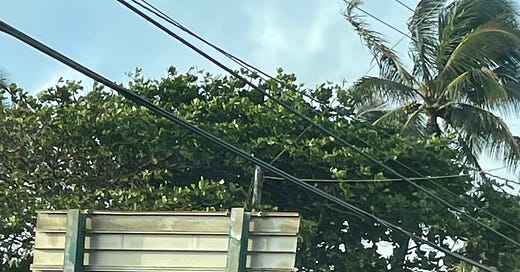I’m just back from a spring break week in Hawaii, where I got bronchitis (boo!) but also saw a lot of signs of investment dollars starting to flow from the Bipartisan Infrastructure Law (yay!).
Seeing these signs pop up all over the Big Island and Kauai reminded me of just how broad the reach is of the Infrastructure Law, and how many lives these projects are touching. One thing I think isn’t getting enough media attention is that so many investments are specifically flowing to those communities that have long been dependent on the fossil fuel economy, for jobs and tax base in particular. Ensuring dollars for clean energy infastructure, as well as for anchor clean energy projects, flow to these “energy communities” does double duty: diversifies these economies, protecting them from economic fallout from chaning energy patterns, and also broadens the tent of supporters for the whole clean energy agenda.
Here are just two awesome programs, one from BIL and one from the Inflation Reduction Act (IRA), that I’m tracking (Note that you can find out about ALL the programs focused on energy community transition at the clearinghouse we set up when I was at the Dept of Energy, energycommunities.gov):
The Advanced Energy Manufacturing and Recycling Grant Program (known to wonks as the “40209” program), funded by the Bipartisan Infrastructure Law to the tune of $750 million, and focused on helping small and mid-size manufactuers produce or recycle clean energy systems, with a priority on projects in coal plant and mine communities. This program holds a special place in my heart: it was the fisrt DOE program to include the now-standard Community Benefits Plan requirement, asking applicants proposing to put major manufactring projects into communities to take a minute to think through the impact of those projects on the communities and on current and future workers. Creating the CBPs was a recognition by the Secretary and our senior team that while it’s essential to bring cean energy projects and supply chains back to the U.S., these projects won’t necessarily create real community and worker benefits if the recipients don’t have a plan for quality jobs, clear economic and environmental benefits to the surrounding area, and a clear commitment to being good corporate citizens for their communities. A new round of applications for this program JUST OPENED — I hope all of you in the clean energy manufacturing space will brave the DOE website and apply!
The Inflation Reduction Act’s Qualifying Advanced Energy Project Credit Program (known to wonks as the “48c” program), which is an extension of a tax credit that I was proud to be involved in creating back in the American Rescue & Recovery Act days. This one is a tax credit for qualifying clean energy manufacturing and industrial decarbonization projects that has a statutory carve-out of 30 percent just for coal mine and plant communities. That means that those communities facing transition from traditional energy industries have a real shot at the public dollars that will help them build out new, more sustainable, and more resilient manufacturing sectors. While these tax credits are administered by the IRS (like most of the IRA provisions), applications will be initially reviewed by the DOE — meaning there’s a community benefits structure included in these, too.
Why does manufacturing matter so much in energy communities? To be honest, it matters everywhere. If there’s one thing the COVID economic shock taught us, it’s that we can’t be caught flat-footed again with no supply chains to rely on. Even more important to these fossil energy communities is the durability and (if done well) high quality job opportunties that come with new manufacturing investments. These industries are anchor economic investments — creating a new battery manufacturing facility, for instance, can drive other related investments up and down the battery and electric vehicle supply chain, and ultimately anchor an economic renaissance for these communities.
I also love that companies are increasingly getting creative about repurposing fossil energy infrastructure to build out new clean energy industries. (Shout-out here to yet another IRA program, the new Loan Program Office’s Energy Infrastructure Reinvestment program focused on repurposing energy assets and infrastructure). It turns out that shuttered coal plants are actually economic assets: they are interconnected to the grid, have water rights and other industrial permits, and are situated in communities where there’s a density of skilled and trained workers. What’s not to love? Increasingly, orphaned and abandoned oil wells are also becoming opportunities for new energy development (see some of my favorite players in this space, Renewell Energy — started by one of my former students! — and Charm Industrial).
The bottom line, for me: we’re talking about a transition not just TO a new clean energy economy, but FROM a very robust and entrenched fossil energy economy. Whatever we can do to utilize those assets and support those communities to be part of the solution, we should do. I don’t see how we win this fight otherwise.




